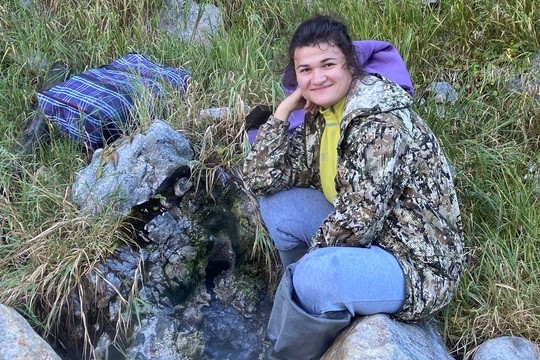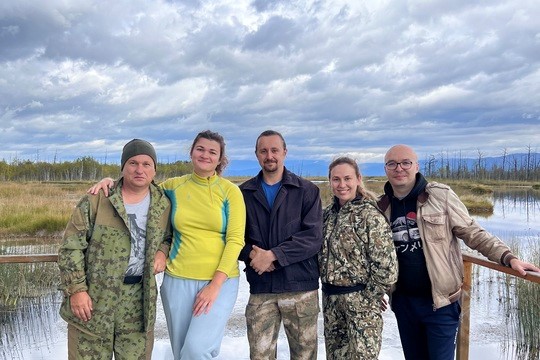For implementation of the Russian Science Foundation grant Project No. 24-77-10035, the research groups of young scientists from Tomsk, Ulan-Ude, Chita, and Birobidzhan have been tasked with identifying the processes and mechanisms of formation of thermal springs in Transbaikalia. To accomplish this, it is essential to study thoroughly not only hot springs, but also the composition of groundwater and water-hosting rocks within a time period spanning at least three yeas.

– Some present investigation result have shown the age of geothermal waters in Transbaikalia to be about 60 thousand years. These hot water sources defined as unique natural objects have attracted interest from broad range of scientists. However, the integrated research is critical in order to provide complete information on their composition, mechanisms of formation and, possibly, more accurate data-driven insights into their age, - says project leader Elena Zippa, senior researcher at the laboratory of hydrogeochemistry and geoecology at the Tomsk branch of Trofimuk Institute of Petroleum Geology and Geophysics, Siberian Branch of the Siberian Branch (TB IPGG SB RAS).
The researches draw primarily on the scientific concept laid down by professor Stepan L. Shvartsev, the founder of the direction of research widely known as “geological evolution and self-organization of the water-rock system”. This concept is rooted in the fact that groundwaters evolve along controlled flow paths with their chemical composition changing over time through water-rock interactions. Concerning evolution of thermal springs, the factual data on the composition of secondary minerals may speak volumes about their origin.
During a recent expedition, a group of scientists represented by Elena Zippa, PhD (geol.-mineral.), and Valeria Drebot, PhD (geol.-mineral.) from TB IPGG SB RAS (Tomsk), Valery Poturai, PhD (geol. –mineral.) from Institute of Complex Analysis of Regional Problems (ICARP FEB RAS, Birobidzhan), Igor Fedorov, from Institute of Natural Resources, Ecology and Cryology (NREC SB RAS (Chita), Mikhail Chernyavsky, PhD (geol.), and Alexander Ukraintsev, PhD (geol.-mineral.), from the N.L. Dobretsov Geological Institute (GIN SB RAS, Ulan-Ude), have examined 14 thermal springs in Transbaikalia.

From left to right: Mikhail Chernyavsky, senior research scientist( GIN SB RAS), Elena Zippa, senior research scientist (TB IPGG SB RAS), Alexander Ukraintsev, research scientists (GIN SB RAS), Valeria Drebot, research scientists (TB IPGG SB RAS), and Igor Fedorov, senior research scientist (NREC SB RAS).
Some of the thermal springs, such as Allinsky, Goryachinsky, Zmeevy, Umkheysky, Kugechersky and Kulinye Bolota, have been intensely exploited, with the infrastructure created for water intake and bathing purposes. However, there are also springs that are difficult to access, e.g. Garginsky spring, one of the most picturesque, with a cascade of waterfalls, and Urinsky spring. To reach the latter, you will need to go along almost seven kilometer long wilderness path in a forest, preferably in company with a local guide carrying a gun!
At each site, the researchers sampled the water, gases and rocks, with the total weight of the samples amounting to more than a hundred kilograms. Now the project participants will have to study the chemical composition of thermal waters, including trace elements, the content of organic matter (TOC) and reduced forms of sulfur, gas composition, along with hydrogen, oxygen, carbon and sulfur isotope composition of in the therms, including radioactive isotopes of carbon and hydrogen, as well as the isotopic composition of nitrogen, methane and helium.
During the expedition works, samples of cold surface and groundwater were taken in mixing spots (where their horizons mix with thermal water), e.g. the Tolstikhinsky hot spring. Researchers sampled both host rocks and secondary minerals whose formation was affected by the thermal waters.
It is expected that such a detailed study of thermal waters will provide more complete insights into the specific features of the main element distribution and relative concentrations of chemical constituents in the therms differing in the composition and geochemistry. This will also provide grounds for the creation of a conceptual model of thermal waters, based on the centuries-old “water-rock” system interactions: just as architects created the fountains of Peterhof, so nature sculpted its amazing monuments! However, researchers are now able to tell us about the specifics of thermal waters of the Transbaikalia.
– While ranking as highly alkaline, these are characterized by low mineralization, and their evolution can be described in the following way: meteoric waters percolated in rocks through cracks to depths of 3-5 kilometers, where they seemed to fall into a closed system unaffected by acids, thus creating favorable conditions for the formation of secondary minerals - clays, carbonates, mica and others. If such secondary mineral as albite is identified in our findings, it will allow us suggesting that the thermal waters of Transbaikalia are much older than it is believed now, - Elena explained.
The project leader also emphasized that in its beauty the nature in Transbaikalia is not inferior to Altai, while remaining quite a virgin land relative to it. It is therefore important that the researchers aim to create the hydrogeochemical database for the region, which can be advantageous from the perspective of mineral water extraction and developing healing tourism.
Source: http://tsc.ru/ru/news/nw_1081.html
Photo courtesy of TB IPGG SB RAS